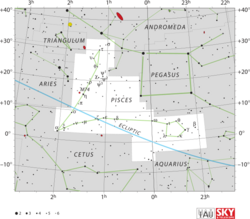Astronomy:Epsilon Piscium
| Observation data Equinox J2000.0]] (ICRS) | |
|---|---|
| Constellation | Pisces |
| Right ascension | 01h 02m 56.60862s[2] |
| Declination | +07° 53′ 24.4855″[2] |
| Apparent magnitude (V) | 4.27[3] |
| Characteristics | |
| Spectral type | K0 III[4] |
| U−B color index | +0.691[3] |
| B−V color index | +0.952[4] |
| Astrometry | |
| Radial velocity (Rv) | +7.47±0.20[4] km/s |
| Proper motion (μ) | RA: −80.17±0.19[2] mas/yr Dec.: +25.59±0.14[2] mas/yr |
| Parallax (π) | 17.94 ± 0.21[2] mas |
| Distance | 182 ± 2 ly (55.7 ± 0.7 pc) |
| Absolute magnitude (MV) | 0.44[4] |
| Details | |
| Mass | 2.27[4] M☉ |
| Radius | 10.9±0.8[5] R☉ |
| Luminosity | 67.6[6] L☉ |
| Surface gravity (log g) | 2.99[7] cgs |
| Temperature | 4,814±40[6] K |
| Metallicity [Fe/H] | −0.39[7] dex |
| Age | 2.56[6] Gyr |
| Other designations | |
| Database references | |
| SIMBAD | data |
Epsilon Piscium (Epsilon Psc, ε Piscium, ε Psc) is the Bayer designation for a star approximately 182 light-years (56 parsecs) away from the Earth,[2] in the constellation Pisces. It is a yellow-orange star of the G9 III or K0 III spectral type, meaning it has a surface temperature around 5,000 kelvins. This is a normal giant star, slightly cooler in surface temperature, yet brighter and larger than the Sun.[8] It is a suspected occultation double, with both stars having the same magnitude, separated by 0.25 arcsecond.[9]
Naming
In Chinese, 外屏 (Wài Píng), meaning Outer Fence, refers to an asterism consisting of ε Piscium, δ Piscium, ζ Piscium, μ Piscium, ν Piscium, ξ Piscium and α Piscium. Consequently, the Chinese name for ε Piscium itself is 外屏二 (Wài Píng èr, English: the Second Star of Outer Fence.)[10] In Japanese, 悠翔星 (Haruto-boshi), meaning "Soaring Forever Star," refers to the Japanese description of ε Piscium.
Planetary system
In 2021, a gas giant planetary candidate was detected by radial velocity method.[11]
| Companion (in order from star) |
Mass | Semimajor axis (AU) |
Orbital period (days) |
Eccentricity | Inclination | Radius |
|---|---|---|---|---|---|---|
| b (unconfirmed) | >0.77+0.16−0.10 MJ | 0.88+0.11−0.10 | 255.3+2.1−1.4 | 0.278+0.122−0.186 | — | — |
References
- ↑ "* eps Psc". SIMBAD. Centre de données astronomiques de Strasbourg. http://simbad.u-strasbg.fr/simbad/sim-basic?Ident=%2A+eps+Psc.
- ↑ 2.0 2.1 2.2 2.3 2.4 2.5 van Leeuwen, F. (2007), "Validation of the new Hipparcos reduction", Astronomy and Astrophysics 474 (2): 653–664, doi:10.1051/0004-6361:20078357, Bibcode: 2007A&A...474..653V.
- ↑ 3.0 3.1 Jennens, P. A.; Helfer, H. L. (September 1975), "A new photometric metal abundance and luminosity calibration for field G and K giants", Monthly Notices of the Royal Astronomical Society 172 (3): 667–679, doi:10.1093/mnras/172.3.667, Bibcode: 1975MNRAS.172..667J.
- ↑ 4.0 4.1 4.2 4.3 4.4 Hekker, S. et al. (August 2006), "Precise radial velocities of giant stars. I. Stable stars", Astronomy and Astrophysics 454 (3): 943–949, doi:10.1051/0004-6361:20064946, Bibcode: 2006A&A...454..943H
- ↑ Nordgren, Tyler E. et al. (December 1999), "Stellar Angular Diameters of Late-Type Giants and Supergiants Measured with the Navy Prototype Optical Interferometer", The Astronomical Journal 118 (6): 3032–3038, doi:10.1086/301114, Bibcode: 1999AJ....118.3032N, http://digitalcommons.wcupa.edu/cgi/viewcontent.cgi?article=1008&context=phys_facpub
- ↑ 6.0 6.1 6.2 Luck, R. Earle (2015), "Abundances in the Local Region. I. G and K Giants", The Astronomical Journal 150 (3): 88, doi:10.1088/0004-6256/150/3/88, Bibcode: 2015AJ....150...88L.
- ↑ 7.0 7.1 Soubiran, C. et al. (June 2010), "The PASTEL catalogue of stellar parameters", Astronomy and Astrophysics 515: A111, doi:10.1051/0004-6361/201014247, Bibcode: 2010A&A...515A.111S.
- ↑ "Hipparcos Star Catalog Entry". http://www.heavens-above.com/hipentry.asp?lat=0&lng=0&loc=Unspecified&alt=0&tz=CET&hip=4906.
- ↑ "VizieR Detailed Page". http://vizier.u-strasbg.fr/viz-bin/VizieR-S?HR%20294.
- ↑ (in Chinese) AEEA (Activities of Exhibition and Education in Astronomy) 天文教育資訊網 2006 年 5 月 19 日
- ↑ 11.0 11.1 Teng, Huan-Yu; Sato, Bun'ei; Takarada, Takuya; Omiya, Masashi; Harakawa, Hiroki; Izumiura, Hideyuki; Kambe, Eiji; Takeda, Yoichi et al. (2022), "Regular radial velocity variations in nine G- and K-type giant stars: Eight planets and one planet candidate", Publications of the Astronomical Society of Japan 74: 92–127, doi:10.1093/pasj/psab112
 |


